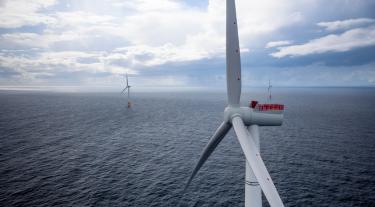In 2019, alongside the Scottish Government, we launched a £1m Floating Wind Technology Acceleration Competition through our Floating Wind Joint Industry Project (JIP) to support innovations with the potential to overcome commercial barriers.
What was the challenge?
Almost 80% of Europe’s offshore wind resource is situated in ocean depths greater than 60 metres – too deep for bottom-fixed wind turbines. So, floating wind technology promises to unlock a multitude of offshore wind generation sites globally, including deep waters surrounding Scotland’s coastline.
Scotland is a leading market for floating offshore wind, home to the world’s first floating wind pilot park, Hywind Scotland and soon to host the world’s largest floating offshore wind farm – the 50MW Kincardine project, currently under construction off the coast of Aberdeenshire.
To stay at the forefront of these developments and to drive cost reductions in deploying offshore wind, the Scottish Government wanted to encourage research and development into floating wind. In particular it wanted to support projects that could address the challenges identified by the Floating Wind JIP, a collaborative research and development initiative between the Carbon Trust, the Scottish Government and leading international offshore wind developers. The Floating Wind JIP’s initial scoping studies identified electrical systems, mooring systems, infrastructure and logistics as areas with significant technological challenges.
The Scottish Government decided to invest £1 million to support innovations that would overcome these challenges. In particular, it was keen to attract solutions from across a wide variety of other sectors including: marine, automotive, oil and gas, aerospace, robotics and manufacturing, that could be applied to floating wind.
How did we help?
We had an existing relationship with Scottish Government as a key supporter of our offshore wind programmes and our experience in delivering technology development projects and competitions meant we were able to deliver the competition quickly and efficiently. In agreement with the offshore wind developers in the Floating Wind JIP, we decided to use this platform to deliver the competition and ensure industry engagement.
We designed the competition to identify, convene, assess and support technologies with the greatest potential to support floating wind development in the following four areas:
- Challenge 1: Exchanging large turbine components on moving floating foundation structures
- Challenge 2: Disconnection and re-connection of foundation structures, when they are towed to and from ports for maintenance
- Challenge 3: Monitoring and inspection of mooring lines, cables and foundation structures
- Challenge 4: Manufacturing, installation and maintenance of mooring lines and anchors
Drawing from over a decade of offshore wind and programme management experience, we established the competition scope and a robust application & evaluation process for entrants.
Having designed the competition, we set out to promote it to relevant innovators from numerous sectors. Media outreach to leading energy-related publications and a digital marketing campaign promoted the competition to key target audiences. We also engaged stakeholders and potential applicants via our extensive networks and presented at relevant events including at five Scottish Enterprise and Forth and Tay cluster events.
We led the evaluation process which involved the FLW JIP developers and an appointed technical consultant, managed contracting of all grant projects, and continue to oversee their progress.
The competition received high quality entries from companies and universities around the world and eight winners were selected.
What were the benefits?
The winning innovations included a 3D-printed concrete suction anchor and a self-charging mooring line monitoring device. Each winner received a share of the £1 million to support various innovation-development activities, from desktop studies to offshore demonstration.
A key benefit for winners was access to the offshore wind developers within the Floating Wind JIP. This provided invaluable insights into their potential customers’ requirements, including the evidence they are looking for from earlier lab and offshore testing, before progressing to commercial deployment.
Each of the winning technologies has evolved with some projects achieving commercial sales, or follow-on development projects, while others are showing promising results from modelling and tank testing.
“The Scottish Government is delighted to have worked closely with the Carbon Trust, providing £1 million of funding towards the Floating Wind Technology Acceleration Competition, to overcome key commercial barriers facing floating wind. The competition received high quality entries, and the eight winners have developed innovative solutions which will allow acceleration of floating wind technology to commercial scale deployment,” said Paul Wheelhouse MSP, Minister for Energy, Connectivity and the Islands, Scottish Government.
Importantly, the competition has generated excitement in the offshore industry and demonstrated Scotland’s commitment to build on its first-mover advantage in floating wind. As outlined in the Scottish Energy Strategy, published in 2017, the Scottish Government expects floating wind to play a prominent role in its transition to net zero economy by 2045 and to be a focus of international collaboration to commercialise the technology.
“We recently published our Offshore Wind Policy Statement, recognising that floating offshore wind will play a vital part in our future renewables generation as we transition to a net zero economy, and in helping us achieve a green recovery from the Covid-19 pandemic.
"We outlined our commitment to supporting research and development to help address challenges associated with achieving commercial scale deployment of floating offshore wind,” said the Minister.
“The work of the Carbon Trust has been excellent. We are pleased to see that our support for this programme is helping to achieve cost reductions, which will not only benefit project cost-competitiveness, and accelerate deployment, but also to lead to economic opportunities in Scotland.”
Image credit: Øyvind Gravås / Woldcam.







